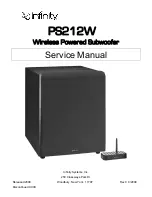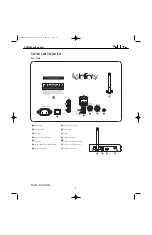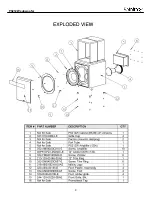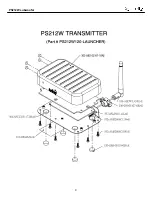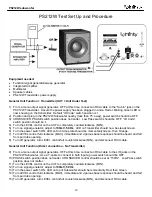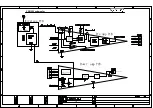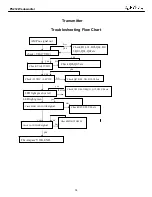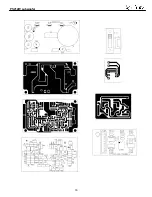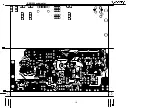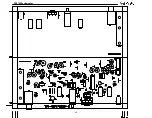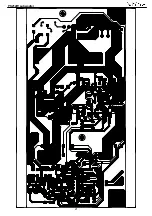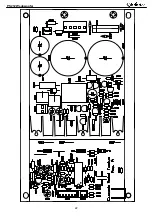
PS210W, PS212W (120V)
that the RCA cable from the source to subwoofer (wired connection) or
transmitter (wireless connection) is functioning properly and that it is
fully inserted at both ends, or that the Transmitter ID-Code Selector
‹
and the Subwoofer ID-Code Selector
¢
are set to the same channel.
Once you have a green or orange LED on the subwoofer, turn your
Subwoofer-Level Control
•
up halfway so that the knob indicator
points up. You should now be hearing bass information coming from
the subwoofer.
Adjust Level
Set the overall volume control of the preamplifier or stereo to a com-
fortable level. Adjust the Subwoofer-Level Control
•
until you obtain
a pleasing blend of bass. Bass response should not overpower the
room but rather be adjusted so there is a harmonious blend across
the entire musical range. Many users have a tendency to set the sub-
woofer volume too loud, adhering to the belief that a subwoofer is
there to produce lots of bass.This is not entirely true. A subwoofer is
there to enhance bass, extending the response of the entire system
so the bass can be felt, as well as heard. However, overall balance
must be maintained or the music will not sound natural. An experienced
listener will set the volume of the subwoofer so that its impact on bass
response is always there but is never obtrusive.
Phase Control
The Phase Switch
ª
determines whether the subwoofer speaker’s
piston-like action moves in and out with the main speakers, 0˚, or
opposite the main speakers, 180˚. Proper phase adjustment depends
on several variables such as room size, subwoofer placement and
listening position. Adjust the phase switch to maximize bass output
at the listening position.
Crossover Adjustment
The Crossover Adjustment Control
¶
determines the highest frequency
at which the subwoofer reproduces sounds. If your main speakers can
comfortably reproduce some low-frequency sounds, set this control
to a lower frequency setting, between 50Hz and 100Hz. This will con-
centrate the subwoofer’s efforts on the ultradeep bass sounds required
by today’s films and music. If you are using smaller bookshelf speakers
that do not extend to the lower bass frequencies, set the Crossover
Adjustment control to a higher setting, between 120Hz and 150Hz.
NOTE
: This control will have no effect if the LFE Input
£
is used
(wired connection) or if the Low-Pass Selector
§
is in the “Off”
position (wireless connection). If you have a Dolby Digital or DTS
processor/receiver, the Low-Pass Frequency is set by the processor/receiver.
Consult your owner’s manual to learn how to view or change this setting.
ID Codes
In the unlikely event that you experience interference when operating
the system, or if you have more than one set of subwoofer transmitters
and receivers in operation, you may change the channel in which the
system operates. On both the transmitter module and the subwoofer,
there is a four-position ID-Code Selector.Try setting both selectors to
a different position. Make sure that the Transmitter ID-Code Selector
‹
and the Subwoofer ID-Code Selector
¢
are set to the same position;
the system won’t function properly unless the positions match.
A maximum of two subwoofers, at least 10' apart, can be operated
using the same transmitter. Simply set the channel selector on the
transmitter and on the two subwoofers to the same channel.
O
PERATION
Power On
Connect your signal source (such as an A/V receiver or preamplifier) to
the transmitter (if using a wireless connection) or to the subwoofer (if using
a wired connection).Two single-RCA cords are provided. While you would
ordinarily use the short cable to connect to the transmitter, or the long
one to connect to the subwoofer, either cable can be used, depending on
proximity to the signal source.There is no need or benefit gained from
connecting the same source to both the transmitter and the subwoofer.
However, you could connect two separate sources to the subwoofer by
utilizing both its wired and wireless connections. Both signals will essentially
be mixed and output by the subwoofer.
Plug your transmitter’s (if using a wireless connection) and subwoofer’s AC
cord into a wall outlet. Do not use the outlets on the back of the receiver
for the subwoofer.
Initially set the Subwoofer-Level Control
•
to the “Min”position.
Turn on your sub by pressing the Power Switch
¡
on the rear panel.
Turn on your entire audio system and start a CD or movie soundtrack
at a moderate level.
Auto On/Standby
Transmitter (Wireless Connection Only):
The Status LED (not shown)
will be lit in red when the unit is in Standby mode. When the transmitter
receives an audio signal from the source, it will immediately turn on
and the LED will turn to blinking green or solid green:
RED = STANDBY (No signal detected, transmitter off)
GREEN (BLINKING) = Transmitter is ON but has not established
a link with the wireless sub
GREEN (SOLID) = Transmitter is ON and has already established
a link with the wireless sub
The transmitter will automatically enter Standby mode after approxi-
mately 10 minutes when no signal is detected from your system.
Subwoofer:
With the Power Switch
¡
in the “On”position, the Status
LED
∞
on the back panel will remain lit to indicate the On/Standby
mode of the subwoofer.
RED = STANDBY (No signal detected, Amp Off)
GREEN = SUB ON (Wired signal detected, Amp On)
ORANGE = SUB ON (Wireless link with transmitter active)
The subwoofer will automatically enter Standby mode after approximately
10 minutes when no signal is detected from your system.The subwoofer
will then power on instantly when a signal is detected. During periods
of normal use, the Power Switch
¡
can be left on. You may turn off
the Power Switch
¡
for extended periods of nonoperation, e.g., when
you are away on vacation.
Getting Started
Confirm that the Status LED on the transmitter is on (red or green),
the Status LED
∞
on the subwoofer is on (red, orange or green) and
an RCA cable is connected from a source unit to either the LFE Input
of the subwoofer
£
or transmitter
›
or L and R inputs
™
on the
subwoofer. Play a CD or video. Use a selection that has ample bass
information. If using a wireless connection, the Status LED on the
transmitter should be lit solid green, and the Status LED
∞
on the
subwoofer should turn orange if connected wirelessly. If the LED on
the transmitter is blinking green and the LED on the subwoofer is
in red or green, a wireless link has not been established between the
transmitter and the subwoofer. If connecting directly to the subwoofer
without using the wireless link, the Status LED
∞
on the subwoofer
should be lit green. If the LED on the subwoofer remains red, check
PS212W.PS210W.OM 5/28/08 4:48 PM Page 6
PS212W
subwoofer
7
Summary of Contents for PS212W
Page 5: ...PACKAGING PS212W subwoofer 4...
Page 9: ...PS212W subwoofer 8...
Page 10: ...PS212W subwoofer 9...
Page 17: ...PS212W subwoofer 16...
Page 18: ...PS212W subwoofer 17...
Page 19: ...2 1 3 2 1 3 PS212W subwoofer 18...
Page 20: ...PS212W subwoofer 19...
Page 21: ...PS212W subwoofer 20...
Page 22: ...PS212W subwoofer 21...
Page 23: ...PS212W subwoofer 22...
Page 43: ...PS212W subwoofer 42...
Page 44: ...Green Red D401 LED_5DIA PS212W subwoofer 43...
Page 46: ...VDD U105 C VEE U105 D 6 5 7 U105 B TL072 2 3 1 TL072 U105 A PS212W subwoofer 45...
Page 49: ...L01 56R 2 1 PS212W subwoofer 48...
Page 51: ...PS212W subwoofer 50...
Page 52: ...PS212W subwoofer 51...
Page 53: ...PS212W subwoofer 52...
Page 54: ...PS212W subwoofer 53...
Page 55: ...PS212W subwoofer 54...

